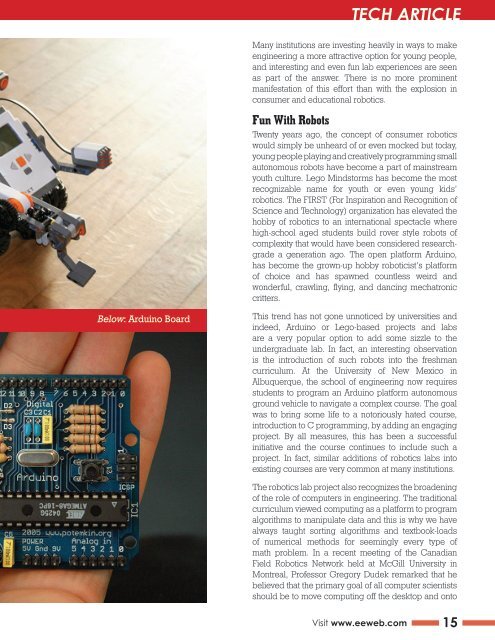Ahmad Bahai - EEWeb
Ahmad Bahai - EEWeb
Ahmad Bahai - EEWeb
Create successful ePaper yourself
Turn your PDF publications into a flip-book with our unique Google optimized e-Paper software.
Below: Arduino Board<br />
TECH ARTICLE<br />
Many institutions are investing heavily in ways to make<br />
engineering a more attractive option for young people,<br />
and interesting and even fun lab experiences are seen<br />
as part of the answer. There is no more prominent<br />
manifestation of this effort than with the explosion in<br />
consumer and educational robotics.<br />
Fun With Robots<br />
Twenty years ago, the concept of consumer robotics<br />
would simply be unheard of or even mocked but today,<br />
young people playing and creatively programming small<br />
autonomous robots have become a part of mainstream<br />
youth culture. Lego Mindstorms has become the most<br />
recognizable name for youth or even young kids’<br />
robotics. The FIRST (For Inspiration and Recognition of<br />
Science and Technology) organization has elevated the<br />
hobby of robotics to an international spectacle where<br />
high-school aged students build rover style robots of<br />
complexity that would have been considered researchgrade<br />
a generation ago. The open platform Arduino,<br />
has become the grown-up hobby roboticist’s platform<br />
of choice and has spawned countless weird and<br />
wonderful, crawling, flying, and dancing mechatronic<br />
critters.<br />
This trend has not gone unnoticed by universities and<br />
indeed, Arduino or Lego-based projects and labs<br />
are a very popular option to add some sizzle to the<br />
undergraduate lab. In fact, an interesting observation<br />
is the introduction of such robots into the freshman<br />
curriculum. At the University of New Mexico in<br />
Albuquerque, the school of engineering now requires<br />
students to program an Arduino platform autonomous<br />
ground vehicle to navigate a complex course. The goal<br />
was to bring some life to a notoriously hated course,<br />
introduction to C programming, by adding an engaging<br />
project. By all measures, this has been a successful<br />
initiative and the course continues to include such a<br />
project. In fact, similar additions of robotics labs into<br />
existing courses are very common at many institutions.<br />
The robotics lab project also recognizes the broadening<br />
of the role of computers in engineering. The traditional<br />
curriculum viewed computing as a platform to program<br />
algorithms to manipulate data and this is why we have<br />
always taught sorting algorithms and textbook-loads<br />
of numerical methods for seemingly every type of<br />
math problem. In a recent meeting of the Canadian<br />
Field Robotics Network held at McGill University in<br />
Montreal, Professor Gregory Dudek remarked that he<br />
believed that the primary goal of all computer scientists<br />
should be to move computing off the desktop and onto<br />
Visit www.eeweb.com<br />
15















